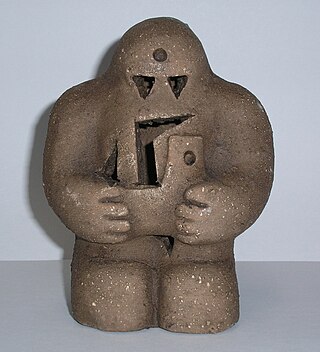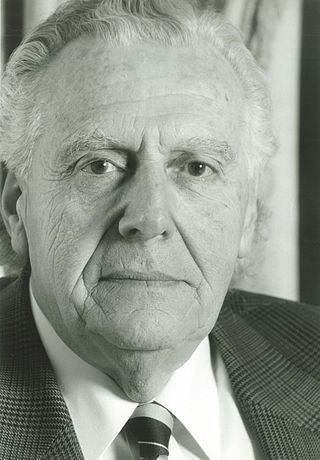
A golem is an animated, anthropomorphic being in Jewish folklore, which is created entirely from inanimate matter, usually clay or mud. The most famous golem narrative involves Judah Loew ben Bezalel, the late 16th-century rabbi of Prague. According to Moment magazine, "the golem is a highly mutable metaphor with seemingly limitless symbolism. It can be a victim or villain, man or woman—or sometimes both. Over the centuries, it has been used to connote war, community, isolation, hope, and despair."

Judah Loew ben Bezalel, also known as Rabbi Loew, the Maharal of Prague, or simply the Maharal, was an important Talmudic scholar, Jewish mystic, mathematician, astronomer, and philosopher who, for most of his life, served as a leading rabbi in the cities of Mikulov in Moravia and Prague in Bohemia.

The John Newbery Medal, frequently shortened to the Newbery, is a literary award given by the Association for Library Service to Children (ALSC), a division of the American Library Association (ALA), to the author of "the most distinguished contributions to American literature for children". The Newbery and the Caldecott Medal are considered the two most prestigious awards for children's literature in the United States. Books selected are widely carried by bookstores and libraries, the authors are interviewed on television, and master's theses and doctoral dissertations are written on them. Named for John Newbery, an 18th-century English publisher of juvenile books, the winner of the Newbery is selected at the ALA's Midwinter Conference by a fifteen-person committee. The Newbery was proposed by Frederic G. Melcher in 1921, making it the first children's book award in the world. The physical bronze medal was designed by Rene Paul Chambellan and is given to the winning author at the next ALA annual conference. Since its founding there have been several changes to the composition of the selection committee, while the physical medal remains the same.

Jewish ethics is the ethics of the Jewish religion or the Jewish people. A type of normative ethics, Jewish ethics may involve issues in Jewish law as well as non-legal issues, and may involve the convergence of Judaism and the Western philosophical tradition of ethics.

Conversion to Judaism is the process by which non-Jews adopt the Jewish religion and become members of the Jewish ethnoreligious community. It thus resembles both conversion to other religions and naturalization. The procedure and requirements for conversion depend on the sponsoring denomination. Furthermore, a conversion done in accordance with one Jewish denomination is not a guarantee of recognition by another denomination. Normally, though not always, the conversions performed by more stringent denominations are recognized by less stringent ones, but not the other way around. A formal conversion is also sometimes undertaken by individuals whose Jewish ancestry is questioned or uncertain, even if they were raised Jewish, but may not actually be considered Jews according to traditional Jewish law.

The Golem is a novel written by Gustav Meyrink between 1907 and 1914. First published in serial form from December 1913 to August 1914 in the periodical Die Weißen Blätter, The Golem was published in book form in 1915 by Kurt Wolff, Leipzig. The Golem was Meyrink's first novel. It sold over 200,000 copies in 1915. It became his most popular and successful literary work, and is generally described as the most "accessible" of his full-length novels. It was first translated into English in 1928.

Mikulov is a town in Břeclav District in the South Moravian Region of the Czech Republic. It has about 7,700 inhabitants. The historic centre of Mikulov is well preserved and is protected by law as an urban monument reservation.

The Old New Synagogue, also called the Altneuschul, situated in Josefov, Prague, is Europe's oldest active synagogue. It is also the oldest surviving medieval synagogue of twin-nave design.
Der Golem is a partially lost 1915 German silent horror film written and directed by Paul Wegener and Henrik Galeen. It was inspired by a Jewish folktale, the most prevalent version of the story involving 16th century Rabbi Judah Loew ben Bezalel who created the Golem to protect his people from antisemites. Wegener claimed the film was based on Gustav Meyrink's 1915 novel The Golem, but, as the movie has little to do with existing Jewish traditions, Troy Howarth states "it is more likely that simply drew upon European folklore".

Many Moons is an American children's picture book written by James Thurber and illustrated by Louis Slobodkin. It was published by Harcourt, Brace & Company in 1943 and won the Caldecott Medal in 1944. The book centers around a young girl, Princess Lenore, who becomes ill, and only one thing will make her better: the Moon. The book was Thurber's first picture book.
Elijah bar Aaron Judah Baal Shem was a Polish rabbi and kabbalist who served as chief rabbi of Chełm. One of the most eminent Talmudists of his generation, he is recorded as the first person known by the epithet "Ba'al Shem" having been considered a great saint and believed to have used miraculous powers to create a golem.
David R. Wisniewski, was an American writer and illustrator best known for children's books.

The Golem: How He Came into the World is a 1920 German silent horror film and a leading example of early German Expressionism. Director Paul Wegener, who co-directed the film with Carl Boese and co-wrote the script with Henrik Galeen based on Gustav Meyrink's 1915 novel, stars as the titular creature, a being in Jewish folklore created from clay. Photographer Karl Freund went on to work on the 1930s classic Universal horror films years later in Hollywood.
Uri Shulevitz is an American writer and illustrator of children's books. He won the 1969 Caldecott Medal for U.S. picture book illustration, recognizing The Fool of the World and the Flying Ship, an Eastern European fairy tale retold by Arthur Ransome in 1916.

It! is a 1967 British horror film directed, produced and written by Herbert J. Leder and starring Roddy McDowall, Jill Haworth and Paul Maxwell. It was made by Seven Arts Productions and Gold Star Productions, Ltd.

Grandfather's Journey is a children’s picture book by Allen Say. The story is told from the perspective of Say, who narrates his grandfather’s immigration between Japan and the United States. Say’s grandfather subsequently moves back to Japan. Released by Houghton Mifflin, the book was positively received by critics and reviewers, and Say received the Caldecott Medal for illustration in 1994. Grandfather’s Journey is often cited as a culturally significant work in its AAPI representation. In 2008, Weston Woods Studios, Inc. made a film based on the book, narrated by B. D. Wong.

The history of the Jews in the Czech lands, historically the Lands of the Bohemian Crown, including the modern Czech Republic, goes back many centuries. There is evidence that Jews have lived in Moravia and Bohemia since as early as the 10th century. Jewish communities flourished here specifically in the 16th and 17th centuries, and again in the late 19th and early 20th centuries. Local Jews were mostly murdered in the Holocaust, or exiled at various points. As of 2021, there were only about 2,300 Jews estimated to be living in the Czech Republic.

Le Golem is a 1936 Czechoslovak monster movie directed by Julien Duvivier in French language.

George R. Whyte was an author, composer, dramatist and art collector. His early education was at Highgate Junior School. A British national of Hungarian Jewish extraction, the Holocaust and the loss of many members of his family in Auschwitz have influenced his creative works which have increasingly focused on the struggle against social injustices especially racism.

The Rough Patch is a 2018 picture book by Brian Lies. An idea of Lies' for more than ten years, when it was published it was well received and was named a 2019 Caldecott Honor book. The story tells of a fox named Evan whose dog dies. Evan then experiences various emotions while grieving before adopting a new dog at the end of the book. The book was praised for Lies' mixed media illustrations, in particular the way he used light and shadow.
















